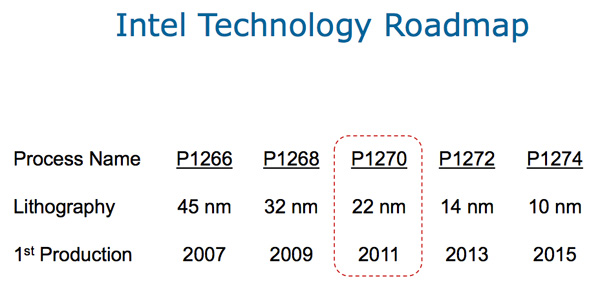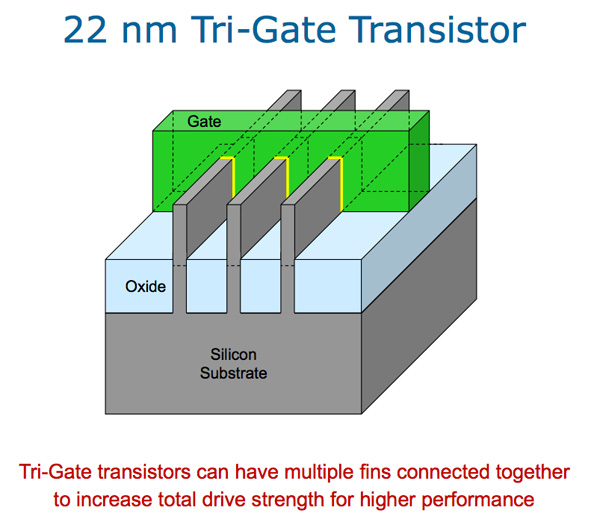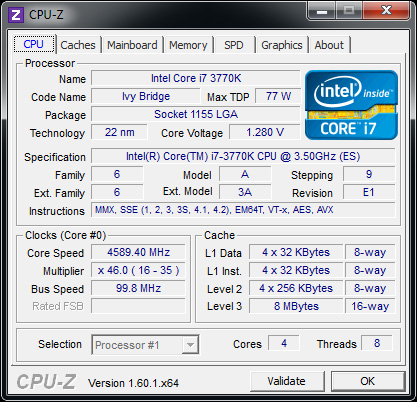The Intel Ivy Bridge (Core i7 3770K) Review
by Anand Lal Shimpi & Ryan Smith on April 23, 2012 12:03 PM EST- Posted in
- CPUs
- Intel
- Ivy Bridge
Overclocking and 22nm
In the old days, whenever Intel transitioned to a new manufacturing process it was accompanied by increased overclocking headroom thanks to the reduction in power consumption and increase in switching speed afforded by the new transistors. To be honest, it's surprising the ride has even lasted this long.

Intel's 22nm process (P1270) is the most ambitious yet. The non-planar "3D" transistors promise to bring a tremendous increase in power efficiency by increasing the surface area of the transistor's inversion layer. It's the vehicle that will bring Intel into new form factors in mobile, but we're around a year away from Haswell's introduction. Rather than 22nm being a delivery platform for Ivy Bridge, it feels like Ivy Bridge is being used to deliver 22nm.

The process is still young and likely biased a bit towards the lower leakage characteristics of lower voltage/lower wattage CPUs, such as those that would be used in Ultrabooks. These two factors combined with some architectural decisions focused on increasing power efficiency result in what many of you may have heard by now: Ivy Bridge won't typically overclock as high as Sandy Bridge on air.
The frequency delta isn't huge. You'll still be able to hit 4.4—4.6GHz without resorting to exotic cooling, but success in the 4.8—5.0GHz range will be limited to water alone for most. Ivy Bridge is also far more sensitive to voltage than Sandy Bridge. Heat dissipation can increase significantly as a function of voltage, so you'll want to stay below 1.3V in your overclocking attempts.
Dr. Ian Cutress, our own Senior Motherboard Editor, put Ivy Bridge through a pretty exhaustive investigation if you want more details on exactly how the chip behaves when overclocking and how best to overclock it.
For the past few years I've been focused on power efficient overclocking. I'm looking for the best gains I can get without significant increases in core voltage. With my 3770K I was able to reliably hit 4.5GHz with only a 140mV increase in core voltage:

The end result is a 15—28% overclock, accompanied by a 32% increase in power consumption. The relationship between overclock speed and power consumption actually hasn't changed since Ivy Bridge, at least based on this datapoint.
| Ivy Bridge Overclocking | |||||
| Intel Core i7 3770K | Stock | 4.6GHz Overclock | % Increase | ||
| Load Power Consumption | 146.4W | 204W | 39.3% | ||
| x264—2nd Pass | 41.8 fps | 49.5 fps | 18.4% | ||
As always, your mileage may vary depending on the particular characteristics of your chip. Ivy Bridge can be overclocked, but at least initially it's not going to be as good of an overclocker as Sandy Bridge. Over time I expect this to improve somewhat as Intel's 22nm process matures, but by how much remains a question to me. It's unclear just how much of these limits are by design vs. a simple matter of process maturity.











173 Comments
View All Comments
hechacker1 - Monday, April 23, 2012 - link
VT-d is interesting if you run ESXi or a Linux based hyper visor, as they allow to utilize VT-d to directly assign hardware to the virtual machines. I think you can even share hardware with it.In Linux for example you could host Windows and assign it a real GPU and get full performance from it.
A while ago I built a machine with that idea in mind, but the software bits weren't in place just yet.
I too with for an overclockable VT-d part.
terragb - Monday, April 23, 2012 - link
Just to add to this, all the processors do support VT-x which is the potentially performance enhancing spec for virtualization.JimmiG - Monday, April 23, 2012 - link
Really annoying how Intel decides seemingly at random which parts get VT-d and which don't.Why do you get it with the $174 i5 3450, but not with the "one CPU to rule them all", everything-but-the-kitchen-sink, $313 i7 3770K?
It's also a stupid way to segment your product line, since 99% of the people buying systems with these CPUs won't even know what it does.
This means AMD also gets some of my money when I upgrade - I'll just build a cheap Bulldozer system for my virtualization needs. I can't really use my Phenom II X4 for that after upgrading - it uses too much power and it's dependent on DDR-2 RAM, which is hard to find and expensive.
dcollins - Monday, April 23, 2012 - link
VT-d is required to support Intel's Trusted Execution Platform, which is used by many OEMs to provide business management tools. That's why the low end CPUs have support and the enthusiast SKUs do not. VT-d provides no benefit to Desktop users right now because desktop virtualization packages do not support it.I agree that it is frustrating having to sacrifice future-proofing for overclocking, but Intel's logic kind of makes sense. Remember, any features that can be disabled will increase yields which means lower prices (or higher margins).
JimmiG - Tuesday, April 24, 2012 - link
VirtualBox, which is one of the most popular desktop virtualization packages, does support VT-d. In fact it's required for 64-bit guests and guests with more than one CPU being virtualized.Does VT-d really use so many transistors that disabling it increases yields? AMD keep their hardware virtualization features enabled even in their lowest-end CPUs (even those where entire cores have been disabled to increase yields)
dgingeri - Monday, April 23, 2012 - link
"I took the last Harry Potter Blu-ray, stripped it of its DRM and used Media Espresso to make it playable on an iPad 2 (1024 x 768 preset)."I wouldn't admit that in print, if I were you. The DMCA goblins will come and get you.
p05esto - Monday, April 23, 2012 - link
They can say they're just kidding and used it as an example, because they would "never" actually do that. I think pirate cops would need more than talk to go to court. Imagine how bad this site would rip into them if they said anything, lol.XJDHDR - Monday, April 23, 2012 - link
Why? No-one loses money from transcode benchmarks. Besides, piracy is the real problem. If it didn't exist, there would be no DRM to strip away.dgingeri - Monday, April 23, 2012 - link
Sure, nobody loses any money, but the entertainment industry pushed DMCA through, and they will use it if they think they could get any profit out of it. It's one law, out of many, that isn't there to protect anyone. It's there so the MPAA and RIAA can screw people over.copyrightforreal - Monday, April 23, 2012 - link
Don't pretend you know shit about copyright law when you don't.Ripping a DVD you own is NOT illegal under the DMCA or Copyright act.
Wikipedia article that even you will be able to comprehend:
http://en.wikipedia.org/wiki/Ripping#Circumvention...